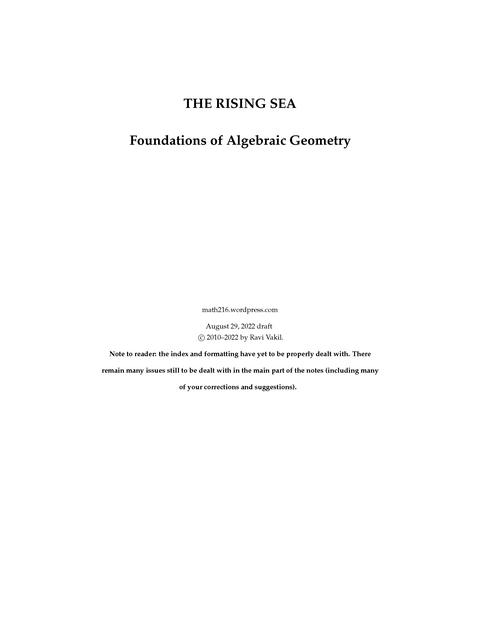
THE RISING SEA: Foundations of Algebraic Geometry
This book is intended to give a serious and reasonably complete introduction to algebraic geometry, not just for (future) experts in the field.
Tag(s): Algebra
Publication date: 29 Sep 2022
ISBN-10: n/a
ISBN-13: n/a
Paperback: 826 pages
Views: 18,633
Type: Textbook
Publisher: n/a
License: Creative Commons Attribution-NonCommercial-NoDerivs 3.0 Unported
Post time: 02 Oct 2022 05:00:00
THE RISING SEA: Foundations of Algebraic Geometry
 This book is intended to give a serious and reasonably complete introduction to algebraic geometry, not just for (future) experts in the field.
This book is intended to give a serious and reasonably complete introduction to algebraic geometry, not just for (future) experts in the field.
Publication date: 29 Sep 2022
ISBN-10: n/a
ISBN-13: n/a
Paperback: 826 pages
Views: 18,633
Document Type: Textbook
Publisher: n/a
License: Creative Commons Attribution-NonCommercial-NoDerivs 3.0 Unported
Post time: 02 Oct 2022 05:00:00
Share — copy and redistribute the material in any medium or format
The licensor cannot revoke these freedoms as long as you follow the license terms.
Click here to read the full license.
Ravi Vakil wrote:This book is intended to give a serious and reasonably complete introduction to algebraic geometry, not just for (future) experts in the field. The exposition serves a narrow set of goals (see §0.4), and necessarily takes a particular point of view on the subject.
Ravi Vakil wrote:0.0.1. The importance of exercises. This book has a lot of exercises. I have found that unless I have some problems I can think through, ideas don’t get fixed in my mind. Some exercises are trivial — some experts find this offensive, but I find this desirable. A very few necessary ones may be hard, but the reader should have been given the background to deal with them — they are not just an excuse to push hard material out of the text. The exercises are interspersed with the exposition, not left to the end. Most have been extensively field-tested. The point of view here is one I explored with Kedlaya and Poonen in [KPV], a book that was ostensibly about problems, but secretly a case for how one should learn and do and think about mathematics. Most people learn by doing, rather than just passively reading. Judiciously chosen problems can be the best way of guiding the learner toward enlightenment.
Tweet
About The Author(s)
Ravi Vakil is a Professor of Mathematics and the Robert K. Packard University Fellow at Stanford University, and was the David Huntington Faculty Scholar.
